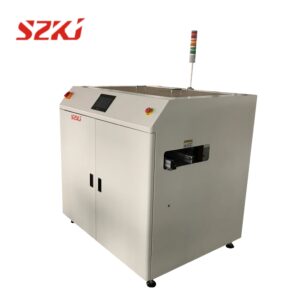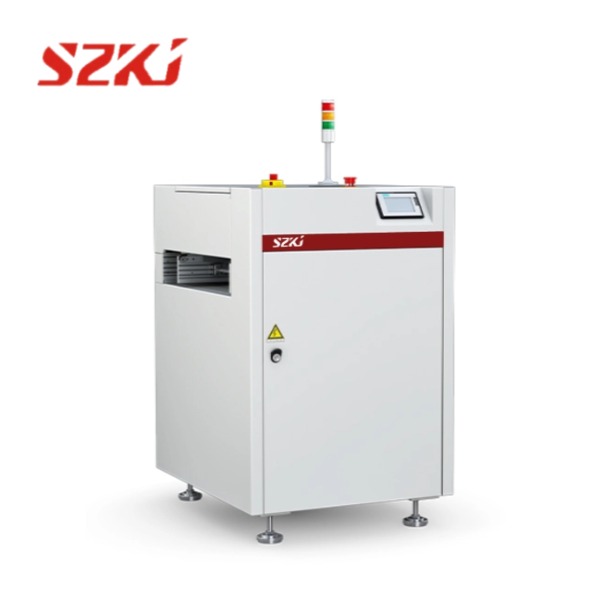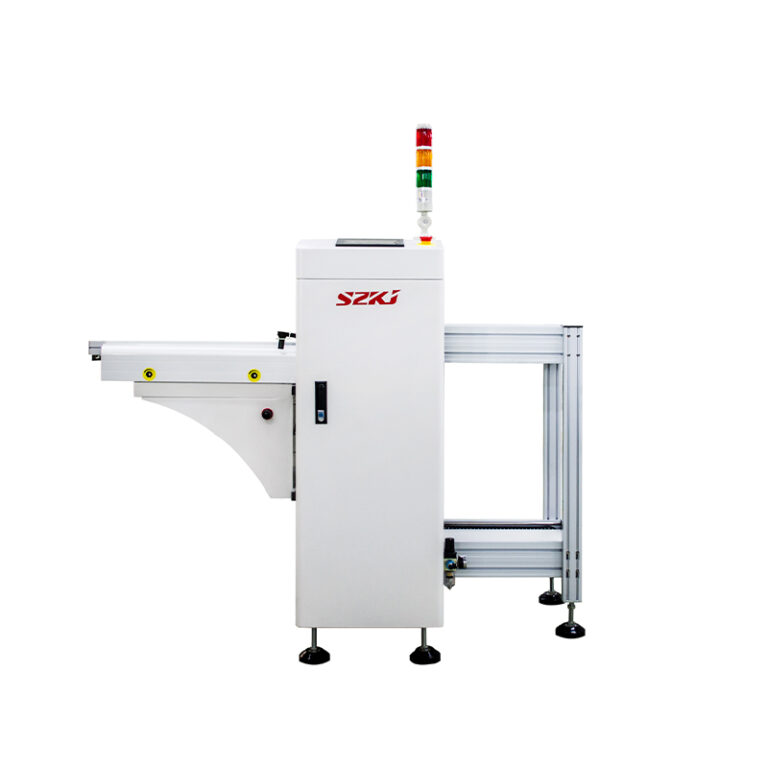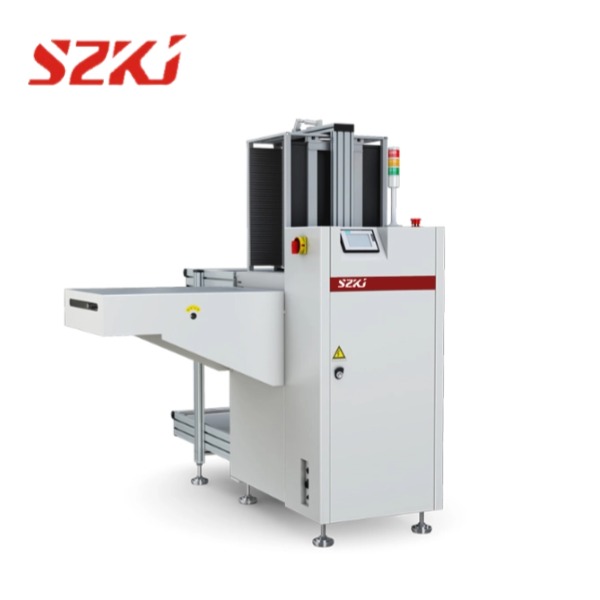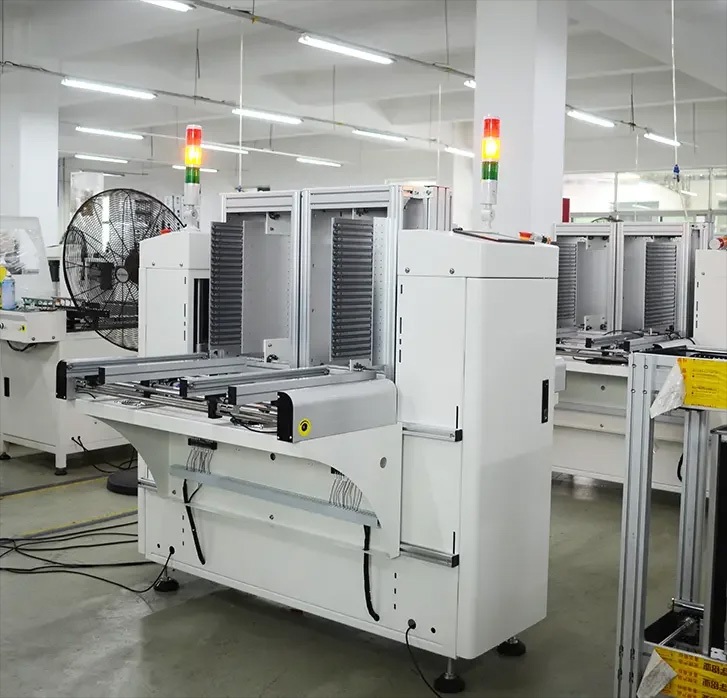Table of Contents
ToggleSurface Mount Technology (SMT) production lines form the backbone of modern electronics manufacturing. Each machine in an SMT production line plays a crucial role in ensuring the precision, efficiency, and reliability of PCB assembly. For manufacturers and engineers seeking to optimize their processes, understanding these key machines is essential. This guide will explore the critical equipment in an SMT production line, as well as highlight how SZKJ’s solutions for board transportation enhance overall productivity.
Solder Paste Printer: The Foundation of SMT Production Line
The solder paste printer is where the SMT production line begins. Its primary function is to deposit solder paste or adhesive onto the pads of a bare PCB. This process determines the foundation for component placement and ultimately affects the quality of solder joints.
Key factors for this machine include print accuracy, repeatability, and compatibility with different PCB sizes. Automated solder paste printers are commonly used to achieve high throughput and precision, minimizing the potential for misalignment or insufficient paste application.
Solder Paste Inspection (SPI): Quality Control After Printing
Following solder paste application, the SPI system inspects the printed boards. This machine ensures that paste thickness, height, and position meet predefined standards. While some production lines skip SPI to save costs, high-end manufacturing environments rely on it to prevent defects early in the process.
An SPI system identifies issues such as insufficient paste, smearing, and bridging, allowing corrective action before components are placed.
Pick and Place Machine: Precision Component Placement
At the heart of any SMT production line is the pick and place machine. This equipment is responsible for rapidly and accurately placing electronic components onto the PCB.
There are two main types:
-
High-speed pick and place machines for small components like resistors and capacitors.
-
Multi-functional pick and place machines capable of handling larger or odd-shaped components.
Performance metrics include placement speed (CPH), placement accuracy, and the maximum size of components supported. These machines are essential for achieving high production rates without sacrificing precision.
Reflow Oven: Achieving Reliable Solder Joints
The reflow oven uses controlled heating to melt the solder paste and form solid connections between components and the PCB. It is divided into multiple temperature zones to ensure even heating across the board.
Key considerations include the number of zones, thermal uniformity, and cooling mechanisms. A well-calibrated reflow process is vital for preventing issues like cold solder joints or component damage due to thermal stress.
Automated Optical Inspection (AOI): Detecting Assembly Defects
AOI systems inspect PCBs post-placement and post-soldering for defects such as misaligned components, missing parts, solder bridges, and open circuits.
There are two main inspection stages:
-
Pre-reflow AOI checks for placement errors.
-
Post-reflow AOI detects soldering issues.
Incorporating AOI into an SMT production line helps maintain high product quality and reduces costly rework.
X-Ray Inspection: Ensuring Hidden Quality
For components like BGAs or CSPs with solder joints hidden beneath their bodies, X-ray inspection is critical. This non-destructive method visualizes hidden solder joints and identifies voids, cold joints, or bridging. It is typically reserved for high-reliability applications where visual inspection is insufficient.
PCB Depaneling Machine: From Panels to Individual Boards
Once assembly is complete, the PCB depaneling machine separates large panels into individual boards. This step requires precision to avoid damaging delicate components or traces during the cutting process.
Board Transportation Equipment: The Invisible Backbone
Beyond core processing machines, board transportation equipment ensures seamless workflow within an SMT production line. These auxiliary devices automate the movement of PCBs between stages, eliminating manual handling and potential bottlenecks. Common board transportation equipment includes loaders, unloaders, conveyors, buffers, flippers, and lifters.
SZKJ’s Contribution: Loaders, Conveyors, and Board Handling Solutions
While core SMT machines like printers and pick and place systems receive much attention, the role of board transportation equipment cannot be underestimated. SZKJ specializes in designing and manufacturing high-quality loaders, conveyors, and other board handling solutions that streamline SMT production lines.
SZKJ Loaders (Board Entry Systems)
Loaders, also referred to as board entry systems, initiate the SMT production line by feeding PCBs automatically from a stack or rack into the line. SZKJ’s loaders are designed for smooth and reliable operation, ensuring that boards enter the production flow without damage or misalignment.
SZKJ Conveyors (Mid-Line Transportation)
Conveyors are essential for connecting different stages of the SMT production line. SZKJ’s conveyor systems ensure PCBs are transported safely and efficiently between machines like the solder paste printer, pick and place, and reflow oven. These systems maintain consistent speed and alignment to support high-throughput operations.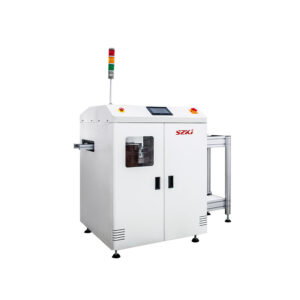
SZKJ Board Handling Solutions (Supporting Equipment)
In addition to loaders and conveyors, SZKJ provides a complete suite of board handling equipment:
-
Unloading systems for collecting completed PCBs.
-
Buffers for temporary storage during line pauses.
-
Flippers and lifters to reorient or elevate PCBs as needed.
This comprehensive approach allows manufacturers to customize their SMT production line for maximum efficiency and minimal downtime.
Why Board Transportation Equipment Matters in SMT Production Lines
While solder paste printers and pick and place machines handle the technical aspects of PCB assembly, board transportation equipment like SZKJ’s loaders, conveyors, and unloaders guarantee operational continuity. They minimize manual intervention, reduce handling errors, and ensure each core machine can work at its full capacity.
Without these auxiliary systems, even the most advanced SMT production line would face bottlenecks, inefficiencies, and increased labor costs.
Conclusion: Building an Efficient SMT Production Line with SZKJ
Every component of an SMT production line—from solder paste printers to reflow ovens—contributes to the overall performance and quality of PCB assembly. Equally important are the transportation systems that connect these machines. SZKJ’s loaders, conveyors, and board handling solutions provide the critical infrastructure to keep production moving seamlessly.
For manufacturers aiming to improve throughput and reliability, investing in both high-performance core machines and robust auxiliary equipment is essential. With SZKJ’s expertise in board transportation, your SMT production line can achieve new levels of efficiency and quality.
